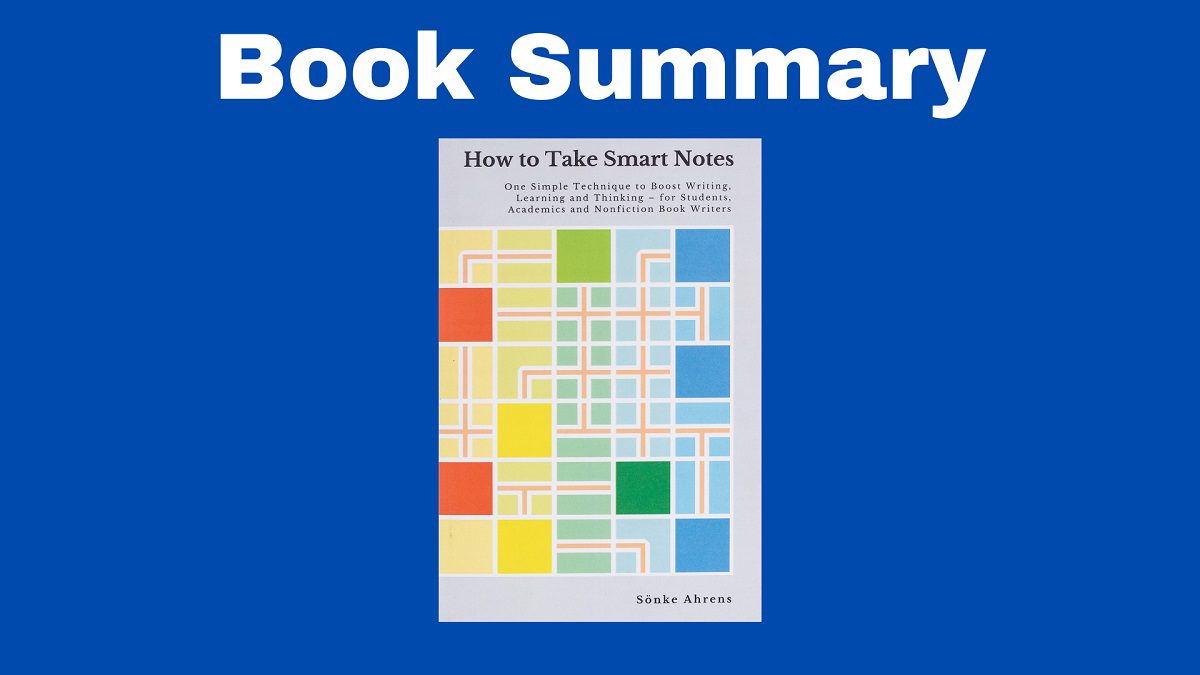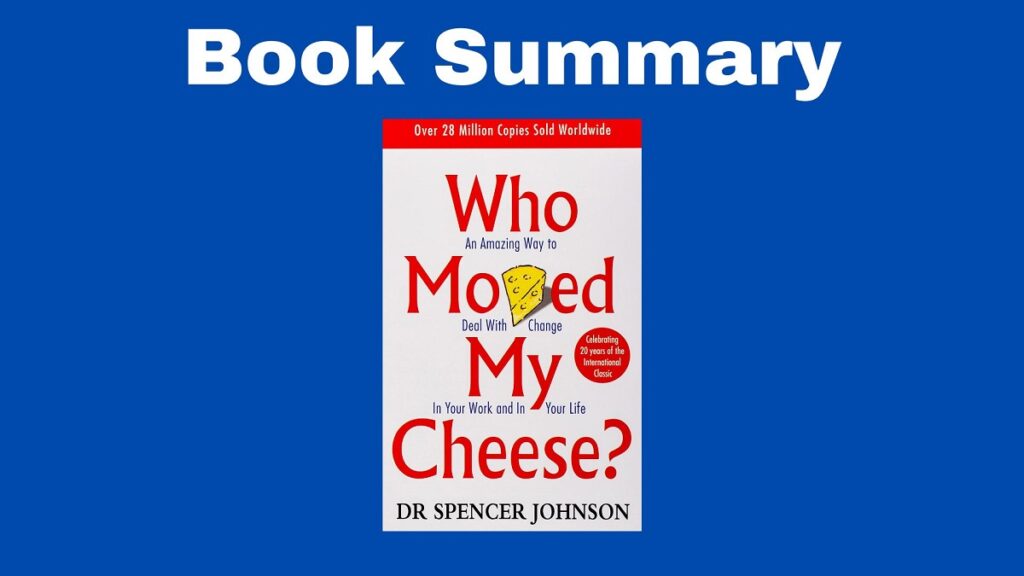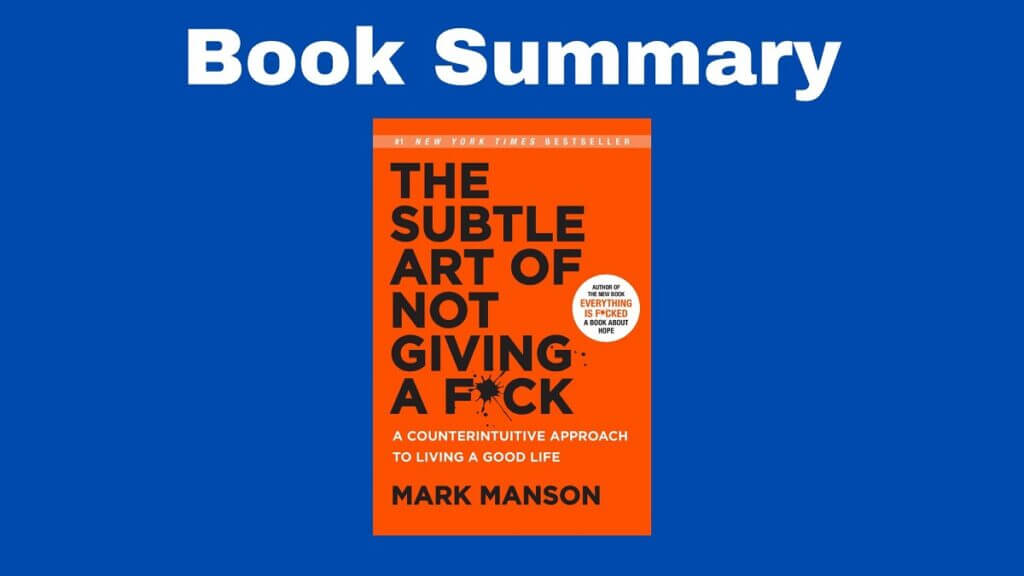The Book in Three Sentences
In this book summary of How to Take Smart Notes, you’ll learn an intelligent system that organizes your ideas and notes for you. This is the first guide to describe the Zettelkasten in English which can help students, teachers, and writers to develop more intelligent texts.
How to Take Smart Notes Summary
Introduction
Never ignore note-taking because that’s how you organize writing. The process of writing starts before the blank page. It starts from the notes you’ve collected. This is a basic skill that’s often overlooked. Good writing is also good note-taking. The key to good writing is preparation.
Chapter 1: Everything You Need to Know
Having a system you trust relieves you from the burden of remembering everything. When it comes to writing, you should be able to focus on one thing at a time.
1.1. Good Solutions Are Simple and Unexpected
You don’t need a complex system and you don’t need to reorganize what you have. What you need instead is to take down smart notes. In order to deal with the complexity of most notes, you need to keep a simple structure. There’s no preparation needed to start this. From now on, you’re going to change your way of working.
The suggested system is the combination of two ideas: the slip-box and a daily routine/workflow similar to that of David Allen’s Getting Things Done. The latter involves collecting everything that needs to be taken care of in the same place. Not every aspect of GTD is useful to academia. The main concept used in the context of note-taking is that everything needs to be taken care of in some form and that you should put it in a system you trust. That’s what the slip-box is for.
1.2 The Slip Box
Niklas Luhmann lived in Germany in the 1960s. He read in the evenings and collected notes. His note-taking system was poor, so he decided to add notes to categories in the form of cards and number their corners, and place them on what he called a slip-box. Luhmann soon realized that a note was only as valuable as its context. His collection of notes soon became more than the sum of its parts and Luhmann’s system allowed him to write a doctoral thesis and the habilitation thesis to become a professor, as well as dozens of books, and hundreds of articles.
Why do most people don’t use a slip-box?
- Some people misunderstood Luhmann’s system which lead to disappointing results
- Originally, Luhmann’s system was only explained in resources available in German
- The system is simple and people don’t expect much from it
1.3 The Slix-Box Manual
Here’s how it works: there are two slip-boxes, a bibliographical one with references and the main one with ideas. When Luhmann read something, he wrote the bibliography on one side of the card and notes on the other side. He then looked at the notes and thought about how they could be relevant to his own thinking. Luhmann wouldn’t copy ideas, but he’d rewrite something with his own words, preserving the original meaning and trying to make connections with previous ideas.
Chapter 2: Everything You Need to Know
A series of ideas turn into text thanks to editing, writing a draft, organizing and assembling notes, and reviewing the end result. Your main work involves thinking, reading, and coming up with ideas that then become notes.
2.1 Writing a Paper Step by Step
- Make fleeting notes (these are notes about what’s on your mind), put them in your inbox, and process them later.
- Make literature notes (these are notes about what you read) by keeping things short and by using your own words.
- Make permanent notes (you turn the fleeting notes into permanent ones). Write one per idea. Be clear, use full sentences, and include the source.
- Add notes to the slip box by a) filing each note behind related notes, b) add links to related notes, and c) adding them to the index.
- See what’s there and what’s missing. Collect more notes the more you read.
- Once you have enough notes to write about a topic, collect everything and organize them.
- Turn notes into a first draft. Make changes as you see fit.
- Edit and proofread.
As part of this system, you’re never working on one project, but on several at the same time.
Chapter 3: Everything You Need to Have
The slip-box involves a simple process. The only thing you need is a collection of notes and everything else is considered clutter.
3.1 The Tool Box
These are the resources you need:
- Something to write with and something to write on
- A reference management program
- The slip-box
- An editor
Chapter 4: A Few Things to Keep in Mind
You should write notes to use them, not just to collect them.
The Four Underlying Principles
Chapter 5: Writing Is the Only Thing That Matters
By writing something, you’ve proven you understand it. You should focus on your writing as if nothing else matters. Having to write something as the ultimate goal, makes you more focused. This also makes you a more engaged reader.
Chapter 6: Simplicity Is Paramount
Don’t store notes under topics, store them under contexts you’re more likely to find them in. Don’t treat all your notes as permanent and don’t collect notes related to a specific project. At the same time, don’t treat all notes as fleeting. Permanent notes are important because they make sense long after you’ve forgotten the context where you took them from. Don’t just highlight, underline, or write in the margins, take the time to think and develop your own ideas from those notes.
Chapter 7: Nobody Ever Starts from Scratch
Writing isn’t linear. A writing project always starts from previous ideas and preconceptions. Writing is circular. To decide on a topic to write about, you first have to do research, read, and take down notes.
Chapter 8: Let Your Work Carry Forward
Aim to have a workflow that sustains itself, one that gains momentum and propels you forward. Motivate yourself by becoming better at what you do. Seek constant feedback. Some of the fundamentals of note-taking include expressing someone else’s ideas in your own words, distinguishing the important parts of the text from the less important ones, and combining new notes with old ones. These are all examples of feedback loops.
The Six Steps to Successful Writing
Chapter 9: Separate and Interlocking Tasks
9.1 Give Each Task Your Undivided Attention
Don’t allow email, notifications, and other distractions to interrupt your workflow.
9.2 Multitasking Is Not a Good Idea
Multitaskers feel more productive, but their productivity decreases in both quality and quantity when you compare them to single taskers. Multitasking doesn’t exist because no one can do more than one thing at a time. What you’re doing when multitasking is switching your attention and this is mentally draining. Never try to do something else when you write. Writing involves reading, understanding, reflecting, connecting ideas, structuring, organizing, editing, correcting, rewriting, and more. Not only do we need to focus when we write, but we also have to do it for a long period of time. To stay focused for longer avoid multitasking, get rid of distractions, and separate different types of tasks. Have a clear structure.
9.3 Give Each Task the Right Kind of Attention
Different tasks require different kinds of attention. It isn’t the same to proofread as to outline.
9.4 Become an Expert Instead of a Planner
In order to learn, stop making plans. Develop intuition instead. Internalize the knowledge you need so that you don’t have to think about the rules.
9.5 Get Closure
Our attention and our short-term memory are limited resources. The information we keep on our short-term memory takes up valuable mental resources until we forget it or replace it with more valuable thoughts. The Zeigarnik effect states that opened tasks take up precious space in our short-term memory until we complete them. We can trick our brains into thinking that we have completed those tasks by writing them down.
9.6 Reduce the Number of Decisions
Another limited resource is motivation or willpower. Decision-making is one of the most tedious tasks. As a way to mitigate this, you can limit some choices so that you leave resources for the decisions that matter. Deciding on a system to organize everything is one such choice. This is also helpful because once you’re done, you can restore your willpower and when you come back, you know how to continue. Breaks are important for learning.
Chapter 10: Read for Understanding
10.1 Read with a Pen in Hand
To write, you have to turn notes into text. To write notes, you need a pen when you read. By combining notes from different sources, you create something new. To create useful notes think about what’s mentioned and what isn’t. By having a purpose, your notes become part of a bigger project instead of a chore.
To understand your notes better, writing by hand is better than typing. Handwriting is slower and correcting mistakes more difficult, but they force you to focus on the gist. To understand the gist, you have to understand it first. Writing by hand isn’t about copying, it’s about translating concepts into your own words. Simply copying something doesn’t involve thinking.
10.2 Keep an Open Mind
Smart note-taking involves being selective. Don’t just focus on the arguments you agree on, give a true account of what’s being said. The criterion you should take to write notes is if it is connected or it’s open to connections. Don’t forget to collect discomforting facts. As long as they’re enriching, you don’t have to agree with everything said and having a counterargument is always useful.
10.3 Get the Gist
Looking for the gist amid a deluge of information is extremely important and you learn by doing. Reading and understanding become easier over time. The more clear you are, the more intelligent you’ll be perceived by your audience.
10.4 Learn to Read
Reading and rereading can be confused with understanding. The real test of understanding comes when we try to explain something using our own words. Not writing something down makes reading a waste of time.
10.5 Learn by Reading
Learning requires deliberate practice and effort. One of the best learning methods is elaboration which involves taking down notes and connecting them with others. A slip-box facilitates long-time learning. With a slip-box, can learn constantly and never reread a text again.
Chapter 11: Take Smart Notes
Good readers see the limitations of an approach presented in a text and learn as much from what’s mentioned, but also from what isn’t. They also understand its immediate context, as well as what’s beyond it. Good readers can establish connections between different sources.
11.1 Make a Career One Note at a Time
When it comes to the slip-box, this resource is more than the sum of its parts. Write something every day and over the course of a year, you’ll have a large number of notes to work with.
11.2 Think Outside the Brain
Notes are a way to try and express what’s happening in your brain in a way that makes sense. Thinking requires externalization and writing is a great way of achieving that.
11.3 Learn by Not Trying
The first step of taking smart notes is elaboration. The next step involves transferring the ideas of those notes into our own interconnected thoughts. That’s part of the slip-box so that we can have an ongoing relationship with these notes. It’s not enough to remember facts, you have to be able to understand their greater meaning. The great advantage of using a slip-box is that you learn by connecting a piece of information to other meaningful contexts instead of relying on your memory.
11.4 Adding Permanent Notes to the Slip-Box
Add notes to your slip-box after writing permanent notes.
- Add notes behind the note you refer to and number it
- Add links to other notes on the new one
- Add an entry in the index
- Build a structure of interconnected mental models
12 Develop Ideas
Notes soon become interconnected. The slip-box is a tool that lets us think, not something to think about.
12.1 Develop Topics
The index allows us to find notes. You can also add keywords because as a writer, you have to think about a context in which you’re more likely to find a note useful.
12.2 Make Smart Connections
Making cross-references between notes is important. See this as maintenance and not as a chore. Making connections is a vital part of the system.
12.3 Compare, Correct, and Differentiate
Trying to add an entry twice or confusing someone else’s idea as your own is a common occurrence. The slip-box system doesn’t allow those problems in the first place which is good because it allows us to move forward. Seeing differences between similar notes is also possible. New notes might correct, complement, or improve previous ones.
12.4 Assemble a Toolbox for Thinking
What makes our slip-box such a valuable tool for learning is that notes are interconnected. This provides context. You should learn certain mental models and internalize them. The idea isn’t to know everything, the idea is to know the right things. Knowing several mental models makes you a versatile person since you can use that knowledge in different situations. It’s better to learn from the experiences of others than your own.
12.5 Use the Slip-Box as a Creativity Machine
Creativity isn’t about doing things, it’s about seeing connections. Good ideas need time. They require a process of preparation. Having a slip-box is great because we’re so intimate with its knowledge that it can lead to new discoveries.
12.6 Think Inside the Box
Good academic writing is based on comparing, differentiating, and connecting notes. Playing with ideas also leads to great texts. Abstraction and re-specification are also needed.
12.7 Facilitate Creativity through Restrictions
Consider notes as something limited. We’re also limited by the format itself which only allows one idea per note. Limitations can be liberating. When we remove choices, we unleash potential.
Chapter 13: Share Your Insight
Your slip-box is an idea generator since you can use the connected notes you’ve established to create something new.
13.1 From Brainstorming to Slip-Box Storming
Brainstorming isn’t as useful as it may seem. Having many ideas doesn’t mean they’re good. The clusters of ideas we’ve created as part of our slip-box are infinitely more useful than coming up with random and mediocre ones.
13.2 From Top Down to Bottom Up
Having ideas and questions from our notes is useful because they aren’t random, they’re supported by context.
13.3 Getting Things Done by Following Your Interests
Successful students are usually highly motivated. Follow your interests and take the path that’s more promising to you.
13.4 Finishing and Review
Develop a rough structure, but keep it flexible. Work on different manuscripts simultaneously. Don’t focus on adding notes to current projects only, have several projects going on at the same time.
13.5 Becoming an Expert by Giving Up Planning
Students are terrible at planning. Especially when it comes to determining the time it’ll take them to complete a task.
13.6 The Actual Writing
The first draft is just the first draft. Get rid of those sentences that don’t add anything meaningful.
Chapter 14: Make It a Habit
Build new habits that will replace old ones. For this system, keep a pen and paper whenever you read and make it a routine.
Afterword
Many writers use The Take Smart Notes principle. You should have a slip-box to connect the main ideas from what you read and develop a workflow that supports it. At its core, this system is remarkably simple: read with a pen and paper so that you can create notes that you can connect with other notes.




